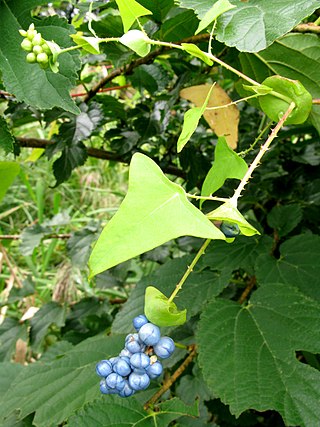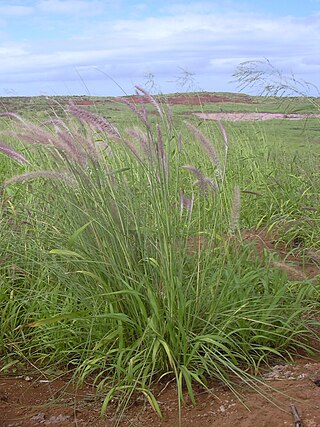
An invasive or alien species is an introduced species to an environment that becomes overpopulated and harms its new environment. Invasive species adversely affect habitats and bioregions, causing ecological, environmental, and/or economic damage. The term can also be used for native species that become harmful to their native environment after human alterations to its food web – for example, the purple sea urchin which has decimated kelp forests along the northern California coast due to overharvesting of its natural predator, the California sea otter. Since the 20th century, invasive species have become a serious economic, social, and environmental threat worldwide.

Salvinia molesta, commonly known as giant salvinia, or as kariba weed after it infested a large portion of Lake Kariba between Zimbabwe and Zambia, is an aquatic fern, native to south-eastern Brazil. It is a free-floating plant that does not attach to the soil, but instead remains buoyant on the surface of a body of water. The fronds are 0.5–4 cm long and broad, with a bristly surface caused by the hair-like strands that join at the end to form eggbeater shapes. They are used to provide a waterproof covering. These fronds are produced in pairs also with a third modified root-like frond that hangs in the water. It has been accidentally introduced or escaped to countless lakes throughout the United States, including Caddo Lake in Texas, where the invasive species has done extensive damage, killing off other life.

Persicaria perfoliata is a species of flowering plant in the buckwheat family. Common names include mile-a-minute, devil's tail, giant climbing tearthumb, and Asiatic tearthumb. It is a trailing herbaceous annual vine with barbed stems and triangular leaves. It is native to most of temperate and tropical eastern Asia, occurring from eastern Russia and Japan in the north, and the range extending to the Philippines and India in the south. P. perfoliata is an aggressive, highly invasive weed.

Heracleum mantegazzianum, commonly known as giant hogweed, is a monocarpic perennial herbaceous plant in the carrot family Apiaceae. H. mantegazzianum is also known as cartwheel-flower, giant cow parsley, giant cow parsnip, or hogsbane. In New Zealand, it is also sometimes called wild parsnip or wild rhubarb.

Alternanthera philoxeroides, commonly referred to as alligator weed, is a native species to the temperate regions of South America, which includes Argentina, Brazil, Paraguay and Uruguay. Argentina alone hosts around 27 species that fall within the range of the genus Alternanthera. Its geographic range once covered only the Parana River region of South America, but it has since expanded, having been introduced to over 30 countries, such as the United States, Japan, China, Australia, New Zealand and many more. This invasive species is believed to have been accidentally introduced to these non-native regions through sediments trapped by, or attached to, tanks and cargo of ships travelling from South America to these various areas.

A number of introduced species, some of which have become invasive species, have been added to New Zealand's native flora and fauna. Both deliberate and accidental introductions have been made from the time of the first human settlement, with several waves of Polynesian people at some time before the year 1300, followed by Europeans after 1769.

Cenchrus setaceus, commonly known as crimson fountaingrass, is a C4 perennial bunch grass that is native to open, scrubby habitats in East Africa, tropical Africa, the Middle East and south-western Asia. It has been introduced to many parts of the world as an ornamental plant, and has become an invasive species in some of them. It is drought-tolerant, grows fast, reaches 3 feet in height, and has many purple, plumose flower spikes.

Myriophyllum aquaticum is a flowering plant, a vascular dicot, commonly called parrot's-feather and parrot feather watermilfoil.
The need for a clearly defined and consistent invasion biology terminology has been acknowledged by many sources. Invasive species, or invasive exotics, is a nomenclature term and categorization phrase used for flora and fauna, and for specific restoration-preservation processes in native habitats. Invasion biology is the study of these organisms and the processes of species invasion.

Hydrocotyle ranunculoides, known commonly as floating pennywort, or floating marshpennywort, is an aquatic plant in the family Apiaceae. It is native to North and South America.

Pontederia crassipes, commonly known as common water hyacinth is an aquatic plant native to South America, naturalized throughout the world, and often invasive outside its native range. It is the sole species of the subgenus Oshunae within the genus Pontederia. Anecdotally, it is known as the "terror of Bengal" due to its invasive growth tendencies.

Cabomba caroliniana, commonly known as Carolina fanwort and various other names, is an aquatic perennial herbaceous plant native to North and South America. Having been a popular aquarium plant, it has been exported around the world, and has become an invasive species in Europe and Australia.

Andropogon virginicus is a species of grass known by several common names, including broomsedge bluestem, yellowsedge bluestem and whiskey grass. It is native to the southeastern United States and as far north as the Great Lakes. It is known as an introduced species in California and Hawaii, where it is weedy.

Faxonius virilis is a species of crayfish known as the virile crayfish, northern crayfish,eastern crayfish, and lesser known as the lake crayfish or common crawfish. Faxonius virilis was reclassified in August 2017, and the genus was changed from Orconectes to Faxonius. It is native to the central United States, east to tributaries of Lake Erie, Lake Ontario, Lake Champlain and the St. Lawrence River in New York and to much of Canada.

Ludwigia peploides is a species of flowering plant in the evening primrose family known by the common names floating primrose-willow and creeping water primrose. It is native to Australia, New Zealand, North America, and South America, but it can be found on many continents and spreads easily to become naturalized. It is well known as a troublesome aquatic noxious weed that invades water ecosystems and can clog waterways. This is perennial herb which grows in moist to wet to flooded areas. The stem can creep over 2 meters long, sometimes branching. It spreads to form mats on the mud, or floats ascending in the water. The leaves are several centimeters long and are borne in alternately arranged clusters along the stem. The flower has 5 to 6 lance-shaped sepals beneath a corolla of 5 or 6 bright yellow petals up to 2.4 centimeters long. The fruit is a hard, cylindrical capsule.

Parthenium hysterophorus is a species of flowering plant in the family Asteraceae. It is native to the American tropics. Common names include Santa-Maria, Santa Maria feverfew, whitetop weed, and famine weed. In India, it is locally known as carrot grass, congress grass or gajar ghas or dhanura. It is a common invasive species in India, Australia, and parts of Africa.

Lygodium japonicum is a species of fern that is known by the common names vine-like fern and Japanese climbing fern. It is native to eastern Asia, including Taiwan, Japan, Korea, southeastern Asia, and India, and eastern Australia. The fern is present in the southeastern United States and Puerto Rico as an introduced species.

Ludwigia grandiflora, the water primrose, is an aquatic plant of the order Myrtales.

Myriophyllum heterophyllum is a species from the genus Myriophyllum native to North America. It was first described by André Michaux.


















